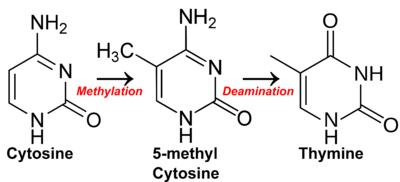CG suppression

CG suppression is a term for the phenomenon that CG dinucleotides are very uncommon in most portions of vertebrate genomes.
In adult somatic tissues, cytosine residues may be methylated, and this occurs almost exclusively within a symmetric CpG context.[1] Methylated C residues spontaneously deaminate to form T residues; hence CpG dinucleotides steadily mutate to TpG dinucleotides, which gives rise to the under-representation of CpG dinucleotides in the human genome (they occur at only 21% of the expected frequency).[2] (On the other hand, spontaneous deamination of unmethylated C residues gives rise to U residues, a mutation that is quickly recognized and repaired by the cell).
In human and mouse, CGs are the least frequent dinucleotide, making up less than 1% of all dinucleotides. GCs are the second most infrequent, making up more than 4% of all dinucleotides, so CGs are more than fourfold less frequent than all other dinucleotides.
See also
References
- ↑ Law J, Jacobsen SE (2010). "Establishing, maintaining and modifying DNA methylation patterns in plants and animals". Nat. Rev. Genet. 11 (3): 204–220. doi:10.1038/nrg2719. PMC 3034103
 . PMID 20142834.
. PMID 20142834. - ↑ International Human Genome Sequencing Consortium; et al. (February 2001). "Initial sequencing and analysis of the human genome". Nature. 409 (6822): 860–921. doi:10.1038/35057062. PMID 11237011.